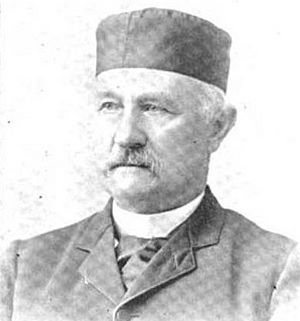Niles Searls facts for kids
Quick facts for kids
Niles Searls
|
|
|---|---|
 |
|
| 14th Chief Justice of California | |
| In office April 1887 – 1889 |
|
| Nominated by | Washington Bartlett |
| Preceded by | Robert F. Morrison |
| Succeeded by | William H. Beatty |
| Personal details | |
| Born | December 22, 1825 Coeymans, New York, U.S. |
| Died | April 27, 1907 (aged 81) Berkeley, California, U.S. |
| Spouse |
Mary Corinthia Niles
(m. 1953) |
| Alma mater | State and National Law School |
Niles Searls (born December 22, 1825 – died April 27, 1907) was an important American lawyer and politician. He served as the 14th Chief Justice of California, which is the highest judge in the state.
Contents
Early Life and Education
Searls was born in Coeymans, New York. His father, Abraham Searls, was a farmer. His mother was Lydia Niles. Niles had three brothers and four sisters.
When he was young, his family moved to Prince Edward, Ontario, Canada. Searls went to school in Wellington for five years. After that, he returned to New York to study at Rensselaerville Academy for three years.
He then spent a year learning about law in a law office. Later, he attended the State and National Law School. He became a lawyer in New York on May 2, 1848.
Journey to California
Searls traveled to Kentucky and Illinois before living in Missouri for a short time to practice law. He decided to join the California Gold Rush in 1849. He traveled to California by wagon train with his friend, Charles Mulford. They arrived in California in October 1849 and worked in mining and trading.
Career in California
In 1850, Searls settled in Nevada City. There, he continued to practice law. Two years later, he was chosen as the district attorney for Nevada County.
From 1855 to 1862, he served as a judge for the 14th judicial district. He was elected as a member of the Know Nothing political party.
Later Political Roles
In 1864, Searls moved back to New York and became a farmer for six years. He then returned to California and planned to retire. However, in 1877, Searls was elected to represent Nevada County in the California State Senate. He later became the Chairman of the California Debris Commission. This group dealt with problems caused by mining waste.
At a big political meeting in 1884, Searls suggested General William Rosecrans to be the candidate for Vice President of the United States. However, Thomas A. Hendricks was chosen instead.
Chief Justice of California
Searls became a Commissioner for the California State Supreme Court in 1885. He served in this role until April 19, 1887. On that date, he became the 14th Chief Justice of California. He was the top judge in the state.
He tried to be re-elected in November 1888 but was not successful. He later served as a Supreme Court Commissioner again from 1894 to 1897. Searls also served on the Board of Directors for the Nevada County Narrow Gauge Railroad.
Personal Life
In 1853, Searls went back to New York to marry his first cousin, Mary Corinthia Niles. They traveled back to Nevada City by steamer. They had two children. One of their children, Fred Searls, also became a lawyer.
Niles Searls kept a diary about a long train trip he took from New York to California in 1869. He later wrote a book about his journey called "Coast to coast by railroad: The journey of Niles Searls--May, 1869".
Searls was the Vice President of the Society of California Pioneers. He was also a Freemason, which is a member of a social and charitable organization.
He retired to Berkeley, California in 1899. He passed away at his home eight years later. He was a Protestant.
Searls' grandson, Fred Searls, Jr., and his great-grandson, Carroll Searls, also became attorneys. His first cousin, Addison Niles, was also a judge on the California Supreme Court from 1872 to 1880.
Burial: Find A Grave Memorial# 48970480
Historic Recognition
Searls' old law office was built in 1872. It was a brick building with two rooms. This building is on Church Street, across from the Nevada County Courthouse. It has been turned into the Searls Library. This library holds a collection of historical documents from the Nevada County Historical Society.

